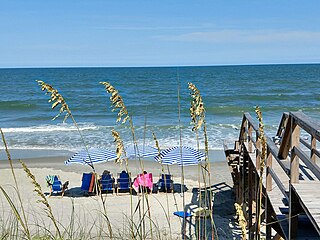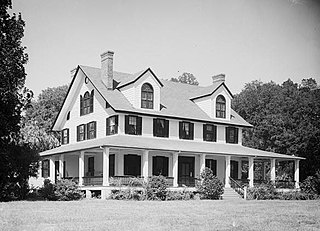
Georgetown County is a county located in the U.S. state of South Carolina. As of the 2020 census, the population was 63,404. Its county seat is Georgetown. The county was founded in 1769. It is named for George III of the United Kingdom.

Georgetown is the third oldest city in the U.S. state of South Carolina and the county seat of Georgetown County, in the Lowcountry. As of the 2010 census it had a population of 9,163. Located on Winyah Bay at the confluence of the Black, Great Pee Dee, Waccamaw, and Sampit rivers, Georgetown is the second largest seaport in South Carolina, handling over 960,000 tons of materials a year, while Charleston is the largest.

Pawleys Island is a town in Georgetown County, South Carolina, United States, and the Atlantic coast barrier island on which the town is located.

James Hoban was an Irish-American architect, best known for designing the White House.

Boone Hall Plantation is a historic district located in Mount Pleasant, Charleston County, South Carolina, United States and listed on the National Register of Historic Places. The plantation is one of America's oldest plantations still in operation, as it has continually produced agricultural crops for over 320 years. The majority of this labor, as well as the construction of the buildings and its characteristic bricks, was performed by enslaved African Americans. For this reason, the site was named one of the African American Historic Places in South Carolina in 2009. The historic district includes a 1936 Colonial Revival-style dwelling, and multiple significant landscape features, including an allée of southern live oak trees, believed to have been planted in 1743. The site is open for public tours.

Auldbrass Plantation or Auldbrass is located in Beaufort County, South Carolina, near the town of Yemassee. The guest house, stable complex and kennels were designed and built by Frank Lloyd Wright from 1939 to 1941. It is one of two structures that Wright designed in South Carolina. The property was purchased in the 1930s by Charles Leigh Stevens. Wright designed the plantation to serve as a retreat for Stevens. During Stevens' retreats he would use the property for riding and hunting excursions.

This is a list of the National Register of Historic Places listings in Georgetown County, South Carolina.

All Saints Church Pawleys Island is a historic church complex and national historic district located in Pawleys Island, Georgetown County, South Carolina. The district encompasses three contributing buildings and one contributing site—the sanctuary, cemetery, rectory, and chapel. In 2004, it left the Episcopal Church to join the Diocese of the Carolinas, now part of the Anglican Church in North America, a denomination within the Anglican realignment movement.

The Millen House is a historic residence on the campus of Indiana University in Bloomington, Indiana, United States. Built by an early farmer, it is one of Bloomington's oldest houses, and it has been named a historic landmark.

The Chicora Wood Plantation is a former rice plantation in Georgetown County, South Carolina. The plantation itself was established sometime between 1732 and 1736 and the 1819 plantation house still exists today. In 1827, Robert Francis Withers Allston (1801–1864) resigned as surveyor-general of South Carolina to take over full-time management of Chicora Wood, which he had inherited from his father. Chicora Wood served as a home base for his network of rice plantations, which produced 840,000 pounds of rice in 1850 and 1,500,000 pounds by 1860. 401 slaves worked the plantation in 1850, increasing to 630 by 1860.

Annandale Plantation, originally known as Millbrook, is a historic plantation house located near Georgetown, in Georgetown County, South Carolina.

Pee Dee River Rice Planters Historic District is a set of historic rice plantation properties and national historic district located near Georgetown, Georgetown County, South Carolina.

Georgetown Historic District is a national historic district located at Georgetown, Georgetown County, South Carolina. The district encompasses 49 contributing buildings in the central business district of Georgetown. The oldest existing structure in Georgetown is a dwelling which dates from about 1737. There are approximately 28 additional 18th century structures as well as 18 buildings erected during the 19th century prior to the American Civil War. The existing structures—homes, churches, public buildings—are of both historical and architectural significance and are situated on heavily shaded, wide streets. The architecture ranges from the simplicity of early colonial, or Georgian, to the elaborate rice plantation era, such as Classical Revival. Notable buildings include the Georgetown County Courthouse, U.S. Post Office, The Rice Museum, Winyah Indigo Society Hall, Masonic Lodge, Antipedo Baptist Church Cemetery, Prince George Winyah Episcopal Church complex, St. Mary's Catholic Church, Kaminski Building, Mary Man House, Dr. Charles Fyffe / Middleton House, John Cleland / Allston House, Samuel Sampson / Henning-Ward House, Robert Stewart / George Pawley House, Martha Allston Pyatt /John S. Pyatt House, Eleazar Waterman / Withers House, and William Waties / Withers House.

Cedar Grove Plantation Chapel, also known as Summer Chapel, All Saints' Episcopal Church, and Waccamaw, is a historic plantation chapel located near Pawleys Island, Georgetown County, South Carolina. It was built in 1898, and is a small, frame vernacular Gothic Revival style chapel. It features a pedimented portico supported by four, paneled, square columns. The chapel is associated with All Saints Church.
Murrells Inlet Historic District is a national historic district located at Murrells Inlet, Georgetown County, South Carolina. The district encompasses 37 contributing buildings and contains a significant concentration of buildings that visually reflect the transition of the area from adjoining estates of two 19th-century rice planters into a 20th-century resort community. The district contains two antebellum houses, which are local interpretations of the Greek Revival style and a collection of early-20th-century vernacular resort buildings. Residential in character, the historic district contains approximately 19 houses. Although they exhibit some diversity, the prevalent use of wood as a building material, the large screened porches, and the setting of moss-draped trees, marshland, and piers provide a visual unity.

The Joel Eddins House is a hall-and-parlor log house on the grounds of Burritt on the Mountain in Huntsville, Alabama, and is the oldest documented building in the state. The house was built in 1810 near present-day Ardmore in Limestone County, Alabama, by Joel Eddins, a settler from Abbeville County, South Carolina. It was moved from its original site to Burritt in 2007. The 1+1⁄2-story house is a hall-and-parlor style, not commonly found in Alabama. An addition was built in the 1930s to the rear, which wrapped around part of the east side; it was not retained when the house was moved to Burritt. The gable roof has brick chimneys on the ends. The main entry opens into the larger "hall" room, which contains a fireplace on the west wall and doors on the other two. A quarter-turn staircase in the northeast corner leads to the upper floor. The eastern door leads to the "parlor" with another fireplace and staircase. The upper floor rooms are the same size as those below, and are not connected. Each room has two small, four-pane windows on either side of the chimney. The 1930s addition contained a bedroom, bathroom, and kitchen. The house was listed on the National Register of Historic Places in 1996.

Rockville Historic District is a national historic district located at Rockville, Charleston County, South Carolina. The district encompasses 19 contributing buildings in the town of Rockville. The dwellings reflect Rockville's historic role as a summer resort town. The houses are characterized by spacious porches, raised foundations, and large central hallways designed for summer comfort and relaxation. Located in the district are the Grace Episcopal Church and Wadmalaw Presbyterian Church.

William Breese Jr. House, also known as the Colonial Inn and the Inn at Brevard, is a historic home located at Brevard, Transylvania County, North Carolina. It was built about 1902, and is a two-story, Classical Revival style frame dwelling with a pebbledash finish and hipped roof. It has a two-story rear ell and features a central, two-story Ionic order entrance portico. It was converted for use as an inn and restaurant around 1955.
In South Carolina ghostlore, the Gray Man is a ghost reportedly seen on the coast of Pawleys Island, South Carolina that warns residents of coming severe storms and hurricanes. Although there are many variations of the legend, most say the Gray Man was first seen in 1822, three years before the town government was incorporated. The last reported sighting was just before Hurricane Florence hit in 2018 and previously just before Hurricane Hugo hit the area in 1989.





















